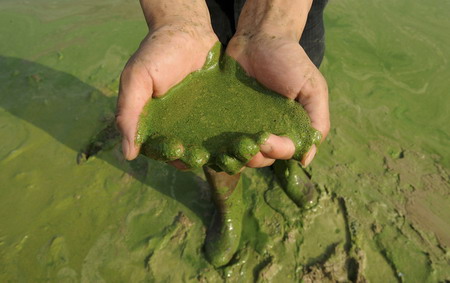
|
|
A fisherman displays algae-filled water at the Chaohu Lake in Hefei, Anhui province, May 1, 2008. Chaohu, the country's fifth largest body of freshwater, suffered blue-green algae outbreak last summer, endangered water supply in nearby cities and posed a great threat to aquatic life, Xinhua News Agency said. [Xinhua]

|
From June to August last year, nutrient runoffs and other pollutants caused blue-green algae blooms in Taihu, Chaohu and Dianchi lakes, endangering water supplies for nearby cities and threatening aquatic life.
The worst algae outbreak was in the eastern Taihu Lake, the country's third largest freshwater lake, and it rendered tap water undrinkable for about 10 days for more than 1 million people in Wuxi, Jiangsu Province.
Blue-green algae occurs naturally in rivers, lakes, damp soil, tree trunks and hot springs.
Meanwhile, the China Meteorological Administration said on Sunday that both the frequency and area of algae appearance were down in April, thanks to pollution control efforts.
Satellite monitoring showed that last month the frequency and area of blue algae appearance in the lake were 64 percent and 44 percent of the level a year ago.
The lake's water quality in the first three months was basically at the same level as that in the same period last year, according to the Taihu Basin Authority.
Early reports said scattered swathes of blue-green algae had been found in some southern parts of the lake, which supplied water to about 30 million people, arousing new concerns about a algae bloom.